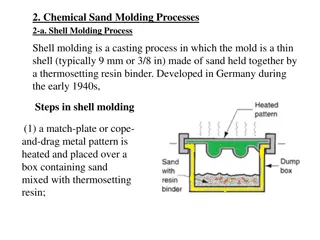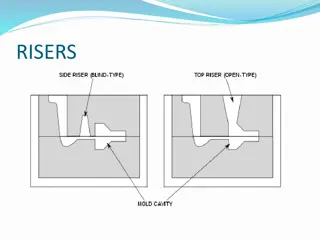Expendable-Mold Casting Processes in Sand Casting: Lecture Insights
Sand casting is a process wherein molten metal is poured into a sand mold, left to solidify, and then the mold is broken to retrieve the casting. This casting method involves pattern making, mold creation, and uses a gating and riser system for complex geometries. Riser design is crucial in managing shrinkage during solidification. Chvorinov's Rule is applied to calculate solidification times for both castings and risers in different examples.
Download Presentation

Please find below an Image/Link to download the presentation.
The content on the website is provided AS IS for your information and personal use only. It may not be sold, licensed, or shared on other websites without obtaining consent from the author.If you encounter any issues during the download, it is possible that the publisher has removed the file from their server.
You are allowed to download the files provided on this website for personal or commercial use, subject to the condition that they are used lawfully. All files are the property of their respective owners.
The content on the website is provided AS IS for your information and personal use only. It may not be sold, licensed, or shared on other websites without obtaining consent from the author.
E N D
Presentation Transcript
Lecture 4 Dr. Suha K. Shihab EXPENDABLE-MOLD CASTING PROCESSES SAND CASTING is a method involving pouring a molten metal into a sand mold. Allowing The metal to solidify, and then breaking up the mold to remove the casting. The casting must then be cleaned and inspected, and heat treatment is sometimes required to improve metallurgical properties. The cavity in the sand mold is formed by packing sand around a pattern and then removing the pattern by separating the mold into two halves. The mold also contains the gating and riser system. In addition, if the casting is to have internal surfaces (e.g., hollow parts or parts with holes), a core must be included in the mold. Since the mold is sacrificed to remove the casting, a new sand mold must be made for each part that is produced. FIGURE 1Steps in the production sequence in sand casting. The steps include not only the casting operation but also pattern making and mold making. 1
Lecture 4 Dr. Suha K. Shihab Figure 2 shows the cross-sectional view of a typical sand-casting mold, indicating some of the terminology. The mold consists of two halves: cope and drag. The cope is the upper half of the mold, and the drag is the bottom half. These two mold parts are contained in a box, called a flask, which is a box divided into two halves, one for the cope and the other for the drag. The two halves of the mold separate at the parting line. The gating system in a casting mold is the channel, or network of channels, by which molten metal flows into the cavity from outside the mold. As shown in the figure, the gating system typically consists of the following : 1. Pouring cup is often used to minimize splash and turbulence as the metal flows into the downsprue. 2. downsprue or spruethrough which the metal enters a runner. 3. runner is a channel that leads into the main cavity. FIGURE 2 closed mold, in which the mold geometry is more complex and requires a gating system (passageway) leading into the cavity. 2
Lecture 4 Dr. Suha K. Shihab RISER DESIGN In addition to the gating system, any casting in which shrinkage is significant requires a riser connected to the main cavity. Riser is a reservoir in the mold that serves as a source of liquid metal for the casting to compensate for shrinkage during solidification and it is used specially in a sand-casting mold. Riser must be designed to freeze after the main casting in order to satisfy its function i.e. to function, the riser must remain molten until after the casting solidifies. Chvorinov srule can be used to compute the size of a riser that will satisfy this requirement. In other words, the TTS for the riser must exceed the TTS for the main casting. Since the mold conditions for both riser and casting are the same, their mold constants will be equal. Example 1: In the casting of steel under certain mold conditions, the mold constant in Chvorinov's Rule is known to be Cm = 4.0 min/cm2, based on previous experience. The casting is a flat plate whose length = 30 cm, width = 10 cm, and thickness = 20 mm. Determine how long it will take for the casting to solidify. Solution: Volume V = 30 x 10 x 2 = 600 cm3 Area A = 2(30 x 10 + 30 x 2 + 10 x 2) = 760 cm2 Chvorinov s Rule: So, TST = Cm (V/A)2 = 4(600/760)2 = 2.49 min 3
Lecture 4 Dr. Suha K. Shihab Example 2: A cylindrical riser must be designed for a sand-casting mold. The casting itself is a steel rectangular plate with dimensions 7.5 cm x 12.5 cm x 2.0 cm. Previous observations have indicated that the total solidification time (TTS) for this casting = 1.6 min. The cylinder for the riser will have a diameter-to-height ratio = 1.0. Determine the dimensions of the riser so that its TTS = 2.0 min Solution: First determine the V/A ratio for the plate. Its volume V = 7.5 x 12.5 x 2:0 = 187.5 cm3, and its surface area A = 2 (7.5 x 12.5 + 7.5 x 2.0 + 12.5 x 2.0) = 267.5 cm2. Given that TTS = 1.6 min, we can determine the mold constant Cm from the Eq., using a value of n = 2 in the equation. Next we must design the riser so that its total solidification time is 2.0 min, using the same value of mold constant. The volume of the riser is given by 4
Lecture 4 Dr. Suha K. Shihab and the surface area is given by Since we are using a D/h ratio = 1.0, then D=h. Substituting D for h in the volume and area formulas, we get Thus the V/A ratio = D/6. Using this ratio in Chvorinov s equation, we have Since h = D, then h = 4.7 cm also So, V = (4.7)3/4 = 81.5 cm3 5
Lecture 4 Dr. Suha K. Shihab SAND MOLDS AND MOLD MAKING Important Features Of The Sand : 1. good refractory properties capacity to stand up under high temperatures without melting or otherwise degrading. 2. distribution of grain size in the mixture, and shape of the individual grains. Small grain size provides a better surface finish on the cast part, but large grain size is more permeable (to allow escape of gases during pouring). Molds made from grains of irregular shape tend to be stronger than molds of round grains because of interlocking, yet interlocking tends to restrict permeability. Foundry sands are silica (SiO2) or silica mixed with other minerals. In making the mold, the grains of sand are held together by a mixture of water and bonding clay. A typical mixture (by volume) is 90% sand, 3% water, and 7% clay. Other bonding agents can be used in place of clay, including organic binders (e.g., phenolic resins) and inorganic binders (e.g., sodium silicate and phosphate). Besides sand and binder, additives are sometimes combined with the mixture to enhance properties such as strength and/or permeability of the mold. 6
Lecture 4 Dr. Suha K. Shihab Several indicators are used to determine the quality of the sand mold: 1) Strength the mold s ability to maintain its shape and resist erosion caused by the flow of molten metal; it depends on grain shape, adhesive qualities of the binder; 2) Permeability capacity of the mold to allow hot air and gases from the casting operation to pass through the voids in the sand; 3) Thermal stability ability of the sand at the surface of the mold cavity to resist cracking and buckling upon contact with the molten metal; 4) Collapsibility ability of the mold to give way and allow the casting to shrink without cracking the casting; it also refers to the ability to remove the sand from the casting during cleaning; 5) Reusability the ability to reuse the sand from the broken mold to make other molds. Types of Sand molds : 1. Green-sand Molds which are made of a mixture of sand, clay, and water. the mold contains moisture at the time of pouring. Advantages 1. Green-sand molds possess sufficient strength for most applications 2. good collapsibility 3. good permeability 4. good reusability 5. They are the least expensive of the molds. 6. They are the most widely used, 7
Lecture 4 Dr. Suha K. Shihab Disadvantages 1. Moisture in the sand can cause defects in some castings, depending on the metal and geometry of the part. 2. Dry-sand molds is made using organic binders rather than clay, and the mold is baked in a large oven at temperatures ranging from 200 C to 320 C. Oven baking strengthens the mold and hardens the cavity surface. Advantages 1. A dry sand mold provides better dimensional control in the cast product, compared to green-sand molding. Disadvantages 1. dry-sand molding is more expensive 2. production rate is reduced because of drying time. 3. Applications are generally limited to medium and large castings in low to medium production rates. 8
Lecture 4 Dr. Suha K. Shihab Advantages of Sand Casting 1) Almost no limit on size, shape, weight or complexity. 2) Sand Casting process can be performed on any metal that can be heated to the liquid state. 3) Sand Casting is the easiest and quickest way (technique) from drawing (design) to the production. 4) low cost. Disadvantages of Sand Casting 1) Limitation on mechanical properties 2) Porosity (empty spaces within the metal - reduces the strength of metal) 3) Poor dimensional accuracy and surface finish 4) Safety hazards to humans and environmental problems 5) Removal of pattern of the thin and small parts is very difficult 9























